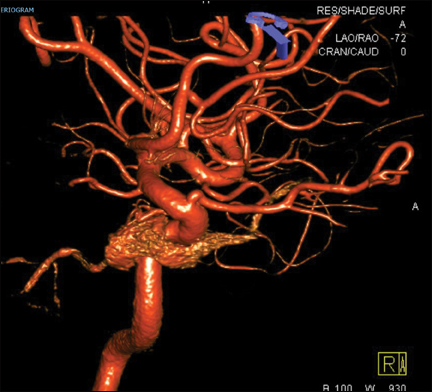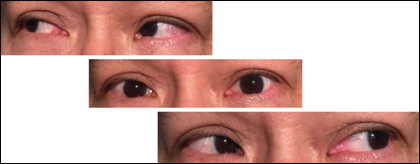Man presents with red eye and ocular hypertension
The left eye had an elevated IOP and 2.5 mm of exophthalmos compared with the right eye.
A 55-year-old male construction worker with no ocular history presented to the Tufts New England Eye Center Comprehensive Ophthalmology Clinic for evaluation of persistent left eye redness with elevated IOP of 3 months’ duration. The red eye had occurred abruptly 3 months prior, and the patient had attributed it to getting grass clippings in his eyes while doing yard work. When the redness persisted for several months, he sought care from an outside eye care provider.
At this initial evaluation, the patient was noted to have marked injection of the left eye and an IOP of 28 mm Hg in the left eye compared with 14 mm Hg in the right eye. According to the notes from the referring provider, a diagnosis of glaucomatocyclitic crisis was suspected, and the patient was started on prednisolone acetate four times a day. When no improvement was noted at follow-up 6 weeks later, he was referred to the New England Eye Center for evaluation.
The patient’s ocular review of symptoms was negative for itching, irritation, foreign body sensation, tearing, eye pain or changes in vision. He did note a mild pressure sensation behind the left eye. His systemic review of symptoms was completely negative. The patient’s medical history was notable only for hyperlipidemia, for which he was taking simvastatin, and seasonal allergies, for which he occasionally took loratadine. He had no known drug allergies. He worked in construction, which required significant heavy lifting, and did not smoke or drink alcohol.
Examination
Upon examination at Tufts, the patient was found to have 20/20 vision in both eyes. Pupils were symmetric and reactive bilaterally without an afferent pupillary defect in either eye. IOP was 16 mm Hg in the right eye and 28 mm Hg in the left. Lids and adnexa were unremarkable, although the patient was noted to have 2.5 mm of exophthalmos in the left eye compared with the right (Figure 1). Extraocular movements were symmetric and full. The conjunctiva in the left eye was injected and remarkable for dilated, tortuous episcleral vessels extending to the limbus 360° (Figure 2). The anterior segment was deep and quiet, and gonioscopy revealed angles that were open to the ciliary body in all four quadrants bilaterally. Lenses were clear, and fundus exam was unremarkable with a cup-to-disc ratio of 0.3 bilaterally and normal course and caliber of the vessels.

Images: Werner A, Barlow A

What is your diagnosis?
See answer on the next page.
Red eye, elevated IOP
Unilateral engorgement and tortuosity of episcleral vessels in the setting of ocular hypertension and proptosis can occur in a variety of entities that increase the episcleral venous pressure. The differential diagnosis includes vascular lesions (A-V malformations, carotid-cavernous sinus fistula, orbital varix, intracranial aneurysm, venous sinus thrombosis), inflammatory conditions that can result in venous compression or blockade (posterior scleritis with vortex vein compression, orbital vasculitis such as Wegener’s, polyarteritis nodosa or giant cell arteritis, orbital pseudotumor, Tolosa-Hunt syndrome), infection (orbital cellulitis, mucormycosis), and space-occupying lesion (orbital tumor, skull base tumor, mucocele or extraocular muscle hypertrophy from thyroid eye disease). Of course, in a situation in which a patient has been on a prolonged course of topical steroids, such as in this case, elevated IOP secondary to steroid response must be excluded.
Upon further questioning, the patient denied any recent trauma, and further examination did not reveal an orbital bruit. OCT of the nerve and macula was normal, and thyroid studies were within normal limits. Given the subacute course of the patient’s symptoms, he was scheduled for a non-urgent MRI/MRA with ophthalmologic follow-up in 1 week, and steroid drops were tapered over the intervening period.
MRI of the orbits revealed asymmetric engorgement of the left superior ophthalmic vein (Figure 3), with prominent enhancing venous structures surrounding the left optic nerve. A small degree of left-sided proptosis was also visible. There was no intraorbital or intracranial mass. MRA showed increased flow through the left cavernous sinus, which radiology felt was evidence of arterial-venous shunting, likely carotid-cavernous fistula.



The patient was referred for neurosurgical evaluation and subsequently underwent diagnostic left cerebral arteriogram, which confirmed the presence of left carotid-cavernous fistula (Figures 4 and 5).
Discussion
Carotid-cavernous fistulas (CCFs) are anomalous connections between the carotid artery and the cavernous sinus. There are multiple ways to categorize these lesions, but the Barrow classification, which determines subtype based on the anatomy of the fistula and the arterial supply, is most often employed. Type A fistulas are direct shunts from the internal carotid artery to the cavernous sinus. Typically, these are high-flow lesions and are associated with major trauma. Type A fistulas classically present with the triad of an abrupt onset pulsating proptosis, chemosis and an orbital bruit. These lesions pose a high risk of progression and morbidity or mortality without closure. In contrast, types B, C and D fistulas are indirect connections between branches of the internal or external carotid arteries and the cavernous sinus. These fistulas are low flow and frequently occur spontaneously. They are associated with atherosclerosis, hypertension, diabetes and collagen vascular disease. These are less likely to result in morbidity and may close spontaneously.
While the classic triad of a CCF includes pulsating exophthalmos, bruit and conjunctival chemosis, the presenting features can be highly variable. Other possible features include elevated IOP, “corkscrew” episcleral vessels, dilated retinal vessels, cranial nerve palsies, decreased visual acuity and pain in the CNV1/2 distribution. Multiple studies have shown that it is not possible to predict the type of fistula (direct vs. indirect) based on clinical features alone. Grumann and colleagues have shown that younger age, history of preceding trauma and orbital bruit are significantly correlated with direct fistulas, while chemosis and elevated IOP are more strongly correlated with indirect fistulas. All other features occur in equal frequency in both types. Because any combination of presenting features may be found in either fistula type, vascular imaging is an essential part of the diagnostic work-up.
Ocular motor paresis is a common presenting feature in both direct and indirect fistulas, present in up to 60% of cases, due to the location of CN3, CN4 and CN6 within the cavernous sinus. The mechanisms by which ocular motor paresis occurs include compression of the nerve, ischemia due to vascular steal phenomenon and thrombosis. CN3 is involved most frequently (approximately 50% of cases) either in isolation or in combination with CN4 and CN6. CN6 palsies without CN3 involvement are found in only 10% of cases, while CN4 palsy without CN3 or CN6 has not been reported. There is some small portion of patients in whom an isolated cranial nerve palsy is the sole presenting feature of a CCF. Therefore, it is important to keep CCF in mind when evaluating patients with new onset ocular motility issues.
Untreated, CCF can lead to serious complications that are both life threatening, such as intracerebral hemorrhage, or vision threatening, including secondary glaucoma, central retinal vein occlusion, choroidal effusion and ischemic optic neuropathy. Any of these findings represents a clear indication for neurosurgical intervention. Other possible indications for treatment include diplopia, intolerable bruit or headache, or severe proptosis leading to exposure keratopathy.
Twenty percent to 60% of indirect CCFs will close spontaneously, and in the absence of clear vision or life-threatening symptoms, observation is a reasonable management option. When intervention is required, transarterial or transvenous embolization of the fistula with a metallic coil or liquid embolization is the preferred technique. This method has an 80% success rate with a relatively low complication rate compared with other methods. Flow-diverting stents have been employed but are complicated by delayed thrombosis and as a result are not the preferred method for closure. Direct surgical intervention with suturing, clipping and ligating can be employed but has high complication rates. Radiation has also been attempted but has highly variable success and a long latency of effect, limiting its utility.
The decision whether to treat a CCF is not a straightforward one, as there are a number of serious complications that can result from neurosurgical intervention. Intracranial complications include cerebral infarction, subarachnoid or intracerebral hemorrhage, sinus rupture and extradural extravasation of contrast. Other reported complications include decreased visual acuity, ophthalmoplegia, diabetes insipidus, retroperitoneal hematoma and femoral vein thrombosis. These risks must be weighed against the likelihood of serious damage from the fistula itself.
After treatment, the symptoms of chemosis and proptosis generally resolve within hours to days, while cranial nerve palsies resolve over weeks. Interestingly, up to 42% of patients will experience a transient worsening of some of their symptoms, although usually this resolves over several weeks. Some patients will experience persistent ocular symptoms despite radiographic evidence of successful closure of the fistula. Presumably these patients had incurred irreversible damage before treatment or have some degree of residual fistula. Decreased visual acuity, age older than 40 years and elevated IOP at presentation have been associated with the persistence of visual symptoms of any kind after treatment. No significant difference in visual prognosis has been observed regarding type of fistula, amount of proptosis or whether orbital bruit or cranial nerve palsy is present at initial diagnosis.

Clinical course continued
The patient underwent coil embolization of the left CCF using a transvenous approach via the left inferior petrosal sinus. Repeat MRI/MRA on postoperative day 1 showed no evidence of infarction and a small amount of residual flow-related enhancement within the left cavernous sinus, although greatly improved compared with preoperative studies. There was rapid improvement in the patient’s clinical exam with normalization of IOP to 14 mm Hg and decrease in proptosis to within 1.5 mm of the other eye by day 2. Episcleral venous dilation resolved by postoperative week 1 (Figure 6).
Summary
CCF can present in a variety of ways but should be considered in patients with elevated IOP, a red eye and proptosis. The ophthalmologist plays a critical role in the management of CCF in suspecting the diagnosis, acquiring the appropriate imaging studies and referring to neurosurgery for management of the vascular lesion. After making the diagnosis, the ophthalmologist plays an important ongoing role in recognizing ophthalmic indications for intervention to help guide the neurosurgeon, treating any ophthalmic complications such as secondary glaucoma and monitoring for success of the neurosurgical intervention or recurrence of the initial lesion.
- References:
- Bailey CR, et al. J Gen Intern Med. 2017;doi:10.1007/s11606-016-3860-6.
- Chaudhry IA, et al. Middle East Afr J Ophthalmol. 2009;doi:10.4103/0974-9233.53862.
- de Keizer R. Orbit. 2003;doi:10.1076/orbi.22.2.121.14315.
- Du B, et al. Neuropsychiatr Dis Treat. 2016;doi:10.2147/NDT.S96588.
- Ellis JA, et al. Neurosurg Focus. 2012;doi:10.3171/2012.2.FOCUS1223.
- Grumann AJ, et al. Int Ophthalmol. 2012;doi:10.1007/s10792-012-9550-4.
- Kurata A, et al. AJNR Am J Neuroradiol. 1993;14(5):1097-1101.
- Lang M, et al. J Neurosurg. 2016;doi:10.3171/2016.5.JNS152372.
- Miller NR. Neurosurg Clin N Am. 2012;doi:10.1016/j.nec.2011.09.008.
- Phan K, et al. World Neurosurg. 2016;doi:10.1016/j.wneu.2016.08.087.
- For more information:
- Astrid Werner, MD, and Alan Barlow, MD, can be reached at New England Eye Center, Tufts University School of Medicine, 750 Washington St., Box 450, Boston, MA 02111; website: www.neec.com.
- Edited by Jessica Moon, MD, and Emily C. Wright, MD. They can be reached at the New England Eye Center, Tufts University School of Medicine, 750 Washington St., Box 450, Boston, MA 02111; website: www.neec.com.
